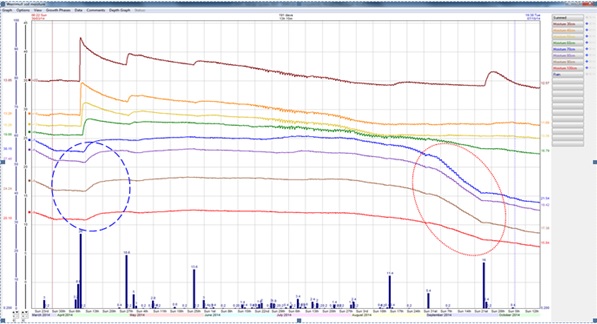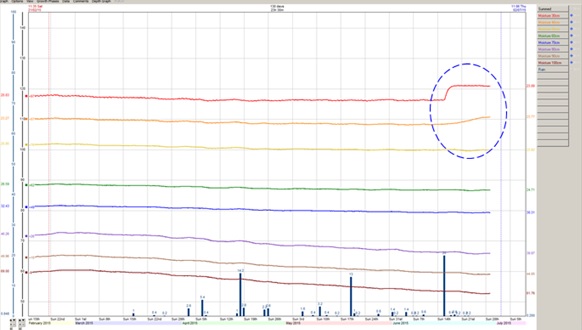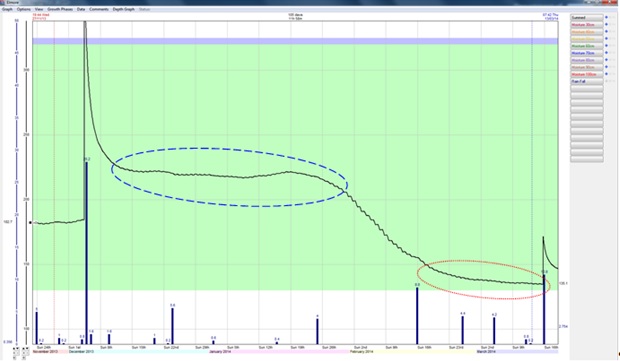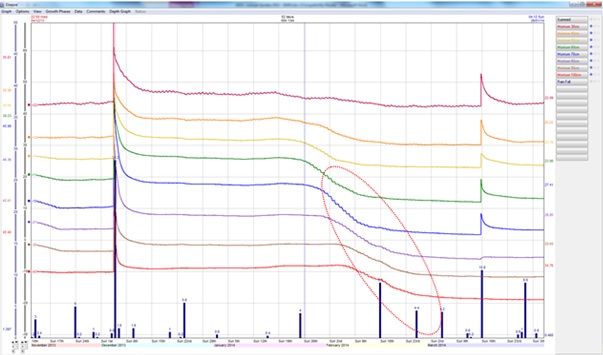Managing seasonal variability with soil moisture monitoring devices
Author: Dale Boyd, (Department of Economic Development, Jobs, Transport and Resources) | Date: 21 Jul 2015
Take home messages
- Under the expected scenario of greater climate variability, the importance of input decisions based on a sound estimate of water limited yield potential through modelling or moisture probes will increase.
- Knowledge of deep soil moisture levels may assist growers with management decisions determining crop type and inputs such as nutrition, and consequently may assist with risk management.
- DEDJTR is developing a system that others may use as a pathway to implement monitoring devices on farm.
- Understanding how long a full profile of soil moisture lasts in normal spring conditions will provide essential information for farmers to make decisions during the growing season.
Background
Grain growers need to measure and monitor soil-water. The current method for collecting accurate plant available water content data is labour intensive and has a high cost which deters farmers from implementing. This leads farmers to use very subjective methods such as rainfall records, plant observation and crop conditions as a way of determining soil moisture. Grain growers would prefer a rapid, cost effective method that over time will provide them with knowledge of soil upper and drained lower limits and values in between during the growing season. Soil moisture probes can deliver this and in doing so, enhance on farm decision making.
Soil moisture probes have now been successfully implemented in dryland cropping systems across the state with a range of state government and community funded projects. Early adopters in the industry have also self-funded their investment in the technology for greater on farm benefits. Interest from both service providers and farmers continues to increase with greater understanding of the data and self interpretation of regional conditions in a time efficient manner that displays actual soil conditions, rather than an estimate.
In 2011, the national GRDC Farm Practices Survey reported an increase in the percentage of the crop where soil moisture is being assessed through the season in Victoria since the previous survey in 2009. In-crop soil-moisture monitoring has grown in all cropping areas and l would expect that this has continued to increase since 2011, particularly in Victoria with a vast network of monitoring points across the state.
The Department of Economic Development, Jobs, Transport and Resources (DEDJTR) conducts a seasonal risk project, where extension products are distributed to the grains industry including state wide soil moisture monthly summaries and various media products (e.g. ‘The Break’).
The DEDJTR’s recent evaluation of the use of soil moisture probes with clients that regularly received monthly correspondence (50:50 split of advisers and growers) found that:
- 95% of people rated the single source point monitoring system as a rough guide to seasonal conditions with 60% of respondents to the survey thinking the information is relevant to their business. The information is being used to confirm decision making during the growing season.
- A high percentage of people exposed to the data responded that their ability to assess soil moisture conditions had improved since the project started four years ago.
- Use of rainfall records is still the main method for the industry to estimate soil moisture levels, as it is simple, convenient and cheap. An essential component to the soil moisture monitoring sites is the automatic rain gauge. Together, the rain gauge and soil moisture probe provide critical pieces of information, including rainfall and the effect of rainfall in the soil water profile. The influence of rainfall in the soil profile can be measured and when calibrated to specific soils provides valuable data for crop management decisions, where previously it was only an estimate. Benefits were also identified with time efficient monitoring and the ability to compare with previous year’s data.
So if you were going to invest in the technology how would you go about it?
Type of probe
A multi sensor probe because it allows measurement down through the profile and preferably every 10cm to provide greater resolution to soil water movement down through the profile. Probes that are resin filled to provide protection to electronic components from water have proven to be robust. Entry level sensors are the suction type (tensiometers) and can be positioned in the profile of most interest.
Communication from paddock to computer
While the cheaper mode of communication is via radio frequency (initial investment and ongoing), the distance this can travel is limited (max 4km) and strict back up of data is required as the only set of data is on the computer which is exposed to corruption. Using the mobile network enables the data to be transmitted from the field to a secure server where the information can be accessed with computers and smart devices (anywhere there is an internet connection). There are monthly costs to be linked with this system, but it allows data sharing where login details are exchanged. Back up technical support or the ability to use remote diagnostics to trouble shoot problems in the paddock are also big advantages with this system.
Monitoring site location
Identify an area that will be the best reference point for the farm, examine soils that have been classified (known water holding ability). Consider paddock zoning and placement of probe in a known performing part of the farm.
Depth of probe measurement
Estimate rooting depth of all crops grown against the soil type and have a probe to extend beyond this. It may not wet to this depth every year but in the wet years, this moisture will be a source that will be used for production. Minimum depth of monitoring is one meter.
Calibration
Calculate millimetres water per sensor zone (eg 10cm) at opportunistic times when the profile may fill to Crop Upper Limit (CUL) and generally at the completion of the growing season when the soil profile is at or near Crop Lower Limit (CLL). Simply compare the capacitance output to the soil samples obtained in the field and actual soil moisture which is determined in the laboratory by gravimetric and volumetric methods of determination
Value add
A weather station that records wind, temperature and humidity will provide additional measurements to the monitoring point and can use the existing telemetry to transmit the information.
Other issues - protection/maintenance
Protect exposed wires and cables with covers and tape and be aware of probe and cable depth in paddock to avoid contact with machinery. Once they are broken they can be difficult to repair.
Automatic rain gauges are not maintenance free and the telemetry equipment should be inspected on an annual basis. Guarding of the telemetry is essential, whether there is stock on farm or not.
Decision making data will only be generated after CUL and CLL is determined. Consequently the first year of data may just generate ‘interesting data’. You could examine artificially wetting up the profile to identify when the soil is saturated for future CUL reference.
What you need to be aware of
In heavy soil types, preferential flow down the soil moisture tube due to the shrinking and swelling characteristics of the soil, may at times provide some false readings but generally will equalise soil moisture content with surrounding soil in a short period.
Different crop types have different root systems and abilities to extract soil moisture.
Verify soil moisture data with field inspections (soil sample to depth to validate moisture is at the depth detected by the probe) to increase confidence in the technology.
An initial investment of around $5,000 is required, but their use will add value each year so consider the cost spread over 10 years instead of the year of purchase.
The strength of the system is to have the monitoring device in the ground, undisturbed for as long as possible, which in time will provide a valuable image of the soil water and plant interactions over a range of variable conditions that naturally occur each season.
Interpretation of soil moisture probe data
Interpreting soil moisture probe data enables users to understand the soil water plant dynamics across a range of situations. Examples from low and medium rainfall zones are presented in the following graphs and data that effects different management decisions is highlighted.
In low rainfall areas, use of soil moisture probes may aid crop choice decision making, by providing pre sowing plant available water data. Time of sowing decision making can also benefit from the use of soil moisture probes, as knowledge of where there is good soil moisture reserves gives confidence to sow by the calendar. In higher rainfall zones with reliable winter rainfall, farmers tend to follow rotations as guided by best management practices and not by soil moisture reserves. However, knowing the soil moisture levels does allow the use of strategic inputs through the growing season to target potential yields.

Jan 2014 Mar May July Sept Nov Jan
Figure 1: Accumulation of soil moisture through summer and autumn from a dry soil profile in the northern Mallee (Werrimull) in 2014 with a summed line to display moisture from 30-100cm.
The oval with the dashed lines (Figure 1, left) displays the accumulation of soil water with rain in February and April on the sandy soils that set up the season with moisture down to one metre. Canola was selected for this paddock to capitalise on these conditions. The dotted oval (Figure 1, right) displays the canola crop using soil water which peaked in September.

Figure 2: Individual soil moisture sensor graph (Werrimull) 2014 growing season.
The dashed oval in April 2014 (Figure 2, left) displays a nice consistent accumulation of soil moisture building up at depths of 70-100cm and the dotted oval (Figure 2, right) highlights the moisture use at depths of 70-90cm during September when the crop was flowering.

Feb March April May June
Figure 3: The oval with the dashed lines (right) display the accumulation of soil water in the soil profile to 40cm with a rain event in June . Up until then, the dry Summer and Autumn had not built upon soil moisture reserves in the measured zone of the capacitance probe. Knowing seasonal forecasts with higher probabilities of a drier than average spring and a measured dry soil profile at sowing, enable farmers to determine crop selection, taking into account paddock history and farm business risk profiles. Crop inputs can be determined by monitoring the moisture reserves (if any) in June and July and part of August.
Use of soil moisture probes out of the winter crop growing season
Summer weeds have a reputation for depleting valuable soil moisture and nutrients if they are allowed to grow. Early in 2014 at a Central Victorian monitoring site, the value of the information generated from moisture probes was highlighted as it displayed the impact of summer weeds. Heliotrope was growing in patches in a paddock of wheat that was cut for hay in October, which at the time, allowed the retention of some deep residual moisture.
The heliotrope germinated early in December 2013 after 25mm of rain, but the impact on deep soil moisture reserves only become apparent at the end of January when soil moisture started to be depleted at 60cm in a stepping effect. This was in line with day time growth and moisture use and night time soil moisture trend lines ‘flatlined’ with the plant shutting down. It took fifty two days for the root system to move down through the profile until it reached the moisture bank at 60cm. You could assume with little water content changes prior to this period that the soil profile 0-50cm has little plant available water but enough to sustain growth of summer weeds.
Eventually the weeds were sprayed but not before evidence of moisture loss down to 100cm. Fortunately this site was on the east side of the state, because in 2014 during July the profile had been ‘topped up’ with great rains. If however, it was in a low rainfall zone then the consequences of not controlling summer weeds early would have been significant. The moral of the story is get the hay bales off the paddock as quickly as possible to aid weed management so that your moisture levels stay in the dashed oval (Figure 4, left) rather than dotted oval (Figure 4, right).

Figure 4: Summed line of total soil moisture and changes through January and February 2014 from summer weeds.

Figure 5: Depletion of soil moisture from summer weeds
The dotted oval (Figure 5) highlights the decrease in soil water content from depths of 60cm down to 100cm after summer weed roots had grown through the dry profile above this depth.
Summary
If you cannot measure it you cannot manage it.
The uptake of new soil moisture monitoring technology is providing a more detailed understanding of soil water dynamics to the southern grains industry particularly with an increasing network of soil moisture probes. The network is a time efficient way to get valuable data.
Large plant water use has been demonstrated when the crop grows through spring in the presence of freely available water. Knowing your moisture status during winter is critical as crops can and will deplete moisture profiles.
Sign up for The Break and Soil Moisture Monitoring summaries from DEDJTR. If the information is of use but you need the repeatable data that is closer or relevant to your circumstances, consider the investment in soil moisture probes.
Contact details
Dale Boyd
PO Box 441, Echuca, 3564
(03) 5482 0439
Dale.Boyd@ecodev.vic.gov.au
Was this page helpful?
YOUR FEEDBACK
